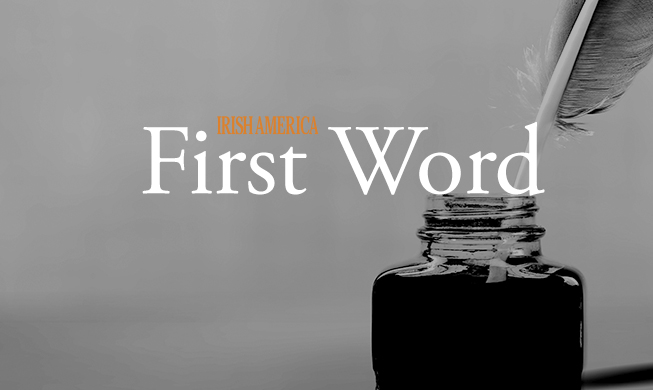
From the time of St. Brendan, the Irish were drawn to America. Maybe it came from gazing out on the vast Atlantic Ocean and wondering what was on the other side. Brendan made his legendary trip in an ox-hide currach. Later the Irish reached “Inishfail” — that “island of destiny” envisioned by the poets — as migratory fishermen making their way to Newfoundland in the holds of brigs which would make the return journey to Britain laden with timber from the Miramichi.
They came as indentured servants and as prisoners transported for crimes against the Crown. Some made their way up from the West Indies where Cromwell had sent them as slaves.
What was merely a trickle in the 17th and 18th centuries became a deluge in the 19th. Fleeing starvation with few or no material possessions, they carried their culture like snails with their houses on their backs, as historian Denis Clarke once remarked. Into the mining camps, onto the railroads, they brought their music and song and tales of home, as they spread out across the land until there was not a corner they didn’t touch or leave their mark upon.
The signs of these early pioneers are to be found all over America. In the Mission Delores Graveyard in San Francisco, where the counties of their homeland are etched on the gravestones. In the Irish bayou in New Orleans, where they perished while building the canals.
In the slums of New York and Boston, where, as one Orestes Brownson wrote in the Quarterly Review (1845): “Out of these narrow lanes, blind courts, dirty streets, damp cellars, and suffocating garrets will come forth some of the noblest sons of our country, whom she will delight to own and honor.”
And indeed out of the wretchedness of those Famine Irish grew the greatest mobilization of a people in the history of the United States. The schools, hospitals, political and labor organizations that came out of their straggle would leave their mark on this country forever.
The current century, which we celebrate in this issue, brought more immigration especially in the 1920s, when thousands fled from the Civil War in Ireland. The great civil rights leader Paul O’Dwyer, profiled in this issue, was one of them. The Irish had found their foothold by then, though there was still discrimination. Financial guru Peter Lynch, who went to college on a “caddy” scholarship, remembered during our interview a couple of years ago that in the 1950s, Tip O’Neill led a boycott on a bank in Boston that had no Catholic employees.
Rising from our inauspicious beginnings, we won all the late rounds, as Pete Hamill, who writes so eloquently on JFK in this issue, once said. And as for that famous Kennedy, he silenced the “No Irish need apply” signs forever.
Now we celebrate the Irish Americans of the century, with faces from the past and the present alike. Members of our annual Top 100 and Business 100 roll calls, who have achieved unprecedented success, rub shoulders alongside those early pioneers such as Henry Ford and Louis Sullivan the architect who pioneered the high-rise, that most American of buildings.
Today’s businessmen and philanthropists are recognized alongside those such as Andrew Mellon and John Quinn, who funded the Irish artistic renaissance. As always, our writers — the chroniclers of our tales and inheritors of the oral traditions — and our artists play their part. There are the community workers, educators, space explorers — Michael Collins in the ’60s and today’s Eileen Collins.
There are the Irish patriots and today’s politicians who have focused their attention on the North of Ireland. John Sweeney, the head of the most powerful union in the world, alongside Mother Jones, the angel of the mining camps. There are the singers and dancers — from the Clancy Brothers to Michael Flatley. From the silver screen there are James Cagney and Gregory Peck, among others. And there are those who gave their lives in the service of this great nation — such as the Sullivan Brothers.
All have touched the lives of millions of Americans. Many were so original and unique in their contribution to American life and culture that things could never be the same again in their individual fields.
Telling the story of our race through people is a vital part of what we do at the magazine. We hope you enjoy this special commemorative issue and take pride in all that has been accomplished by the Irish in America over the century. As Pete Hamill said in a recent speech at John Jay College in New York, “We have won, not over England, but over adversity, bigotry, and self-pity.” Let our success remind us that, as Hamill said, “…these new people — the Mexicans and the Dominicans, the Chinese and the Koreans, the Russians and the Haitians, and all the others — are us. They are the new Irish. We must embrace them.”
Editor’s Note: This article was originally published in the November 1999 issue of Irish America. ⬥


Leave a Reply